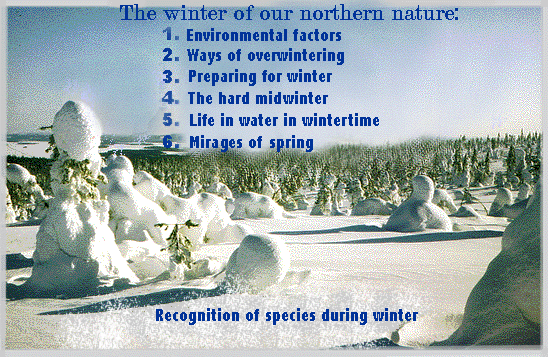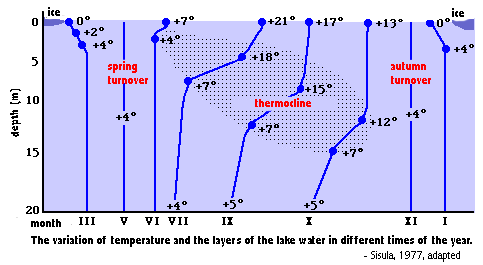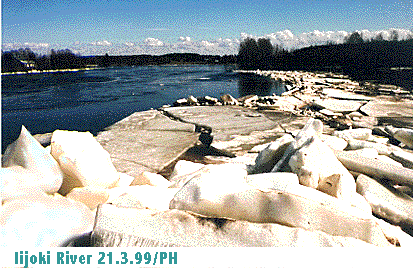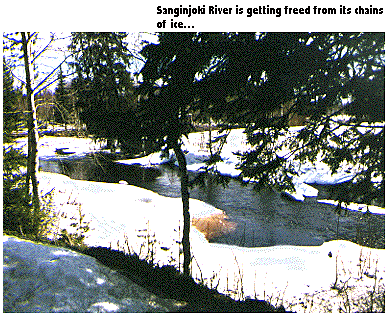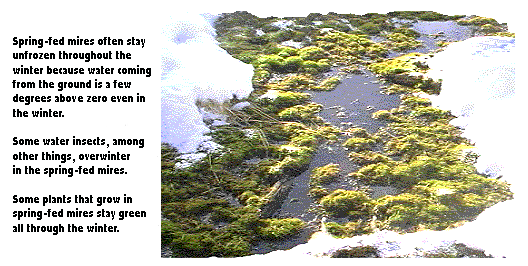The winter does not cause great changes in waters
The conditions in water systems change less
over the seasons than the conditions in terrestial ecosystems. See
also:
Freezing of waters!
Lakes usually freeze by the middle of October In Lapland. In Central Finland, small lakes freeze at the end of November and the middle parts of big lakes at the end of December. Lakes stay frozen in Lapland for about seven months (e.g. Inarinjärvi 216 days and Kilpisjärvi 228 days) and in Southern Finland for about five months (e.g. Päijänne/Tehi 130 days).
The thickness of ice cover is about 60-70
cm in the lakes in Central Finland, but during a cold winter, the
thickness may rise up to even one metre. In running waters,
some slush ice and ground ice may be formed. See also: Rapids in the winter!
Water resources diminish as the winter
progresses. Small brooks may dry out completely in the late winter.
Water in the winter stays at even temperature
In lakes, different layers of water blend in the
spring and in the autumn. The blending is called spring turnover and
autumn turnover. See also: The hydrological cycle!
In the winter, the water
temperature is almost the same - about +4°C - all the way from
the surface to the bottom. Immediately under the ice, however, the
water is colder (about 0 - +4°C).
In the North (mainly in Lapland), the water temperatures,
immediately after the lake has frozen, are slightly higher
(e.g. in Inarinjärvi and in Kevojärvi +3.1°C) than they are in the
South (e.g. in Näsijärvi +1.6°C and in Pielinen/Nurmes +2.5°C). This
is because the waters in Lapland freeze soon after the water
temperature drops below +4°C and therefore, the water remaining
under the ice is warmer than in the South.
In the summer, the cold (=heavy) water lies deeper
and the water in the surface is warm. The layer in which the water
temperature abruptly changes is called a thermocline.
It is dark under the ice and snow
Only a few percent of the light in the air gets
under the ice. Light can easily permeate through snowless, clear
ice, but a snow layer on the ice
prevents the light from getting into the water. As water itself
binds light, it is very dark deeper in the water.
Breaking up of the ice and a flood in Iijoki River
in the spring 1999.
Ice and snow covers prevent the exchange of gases
Immediately after the autumn turnover, there is
plenty of oxygen in the whole body of water.
Organisms use oxygen also in the winter although their
vital functions (e.g. breathing) are weak, and there are a lot less
organisms than there are in the summer. The oxygen production of
water plants and phytoplankton is nearly non-existent. See also: Oxygen in water!
If the ice and snow covers are thick, oxygen may run short
or completely run out, especially in shallow lakes and ponds.
Places where the current is strong and the water stays unfrozen
throughout the winter are important to the oxygen economy of
water organisms, and therefore to the nutrient economy as
well. And surely, lighting is not without significance, either!
The amount of nutrients increases
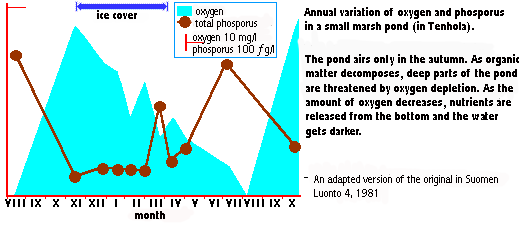
Nutrient concentrations (e.g. phosphorus and
nitrogen) usually increase in the winter (see the picture
above). This is because the consumption of nutrients is low
(there are few organisms and their vital functions are weak), but
still some breakdown of organic matter occurs, if not much. In
addition, the oxygen deficiency / lack of oxygen in the hypolimnion
releases nutrients from the ground sludge.
In the spring, the amount of nutrients (e.g. phosphorus and nitrogen) decreases in surface water because the production of phytoplankton has increased significantly.

